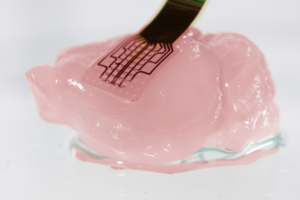 Recent developments on a novel graphene-based sensing platform, which provides high resolution, real-time measuring of brain activity, could be the gateway to unlocking a superior understanding of the brain.
Recent developments on a novel graphene-based sensing platform, which provides high resolution, real-time measuring of brain activity, could be the gateway to unlocking a superior understanding of the brain.
This research, developed in the framework of the EU project BrainCom and participated by the Biomedical Applications Group of the IMB-CNM, is reported in four papers recently published on high impact journals.
Arguably, a better understanding of the working principles of the human brain remains one of the major scientific challenges of our time. Despite significant advances made in the field of neurotechnology in recent years, neural sensing interfaces still fall short of equally meeting requirements on biocompatibility, sensitivity, and high spatio-temporal resolution. The European Union Horizon 2020 research project BrainCom, coordinated by the ICN2 Advanced Electronic Materials and Devices Group led by ICREA Prof. José A. Garrido, is tackling these problems. BrainCom brings together experts from the fields of neurotechnology, neuroscience, and ethics to develop novel technologies capable of overcoming these limitations and shed light onto the mechanisms of information encoding and processing in the brain.
In four research articles published between March and April 2020 — featured in Elsevier’s Carbon, IOP’s 2D Materials, Wiley’s Small, and American Chemical Society’s Nano Letters — researchers from the BrainCom consortium present the technological advances achieved in the project, discuss in-depth methodology, and demonstrate novel capabilities for high resolution sensing of the brain’s electrical activity. The recent developments exploit the unique properties of graphene, an atom-thick layer of carbon, which conforms with the soft and convoluted surface of the brain providing an excellent neural sensing interface. Graphene sensors have an additional advantage that represents a turning point in neural engineering: the sensing mechanism of these graphene active sensors (so-called transistors) is compatible with electronic multiplexing, a technology that enables transmitting the signals detected by multiple sensors through a single micrometric wire. This implies that the number of sensors on the neural implants can be increased while minimizing the footprint of the connectors required to link the implants to external electronic equipment.
This technology, developed in close collaboration with Dr Anton Guimerà at the CSIC Institute of Microelectronics of Barcelona (IMB-CNM, CSIC), has been evaluated in pre-clinical studies at the laboratory of neuroscientist Prof. Anton Sirota at Ludwig-Maximilians Universität (LMU, Munich). A collaborative and multidisciplinary approach is crucial for the success of the project, which aims at addressing a very hard scientific and technological challenge. The human brain has an astonishing complexity, consisting out of as many as 100 billion neurons. To fully understand the underlying principles of such a convoluted system requires the simultaneous detection of the electrical activity of large neural populations with a high spatial and temporal resolution. Unfortunately, current neural sensing technologies present a trade-off between spatial resolution and large-area coverage of the brain surface. The work carried out by the BrainCom project’s researchers shows how graphene-based sensors represent an outstanding building block for such large scale and highly sensitive neural interfaces. As explained in the recently published papers, graphene sensors can be reduced in size to the dimension of about one single neuron, while maintaining a high signal quality. In addition, their sensitivity expands over a wide range of frequencies; from infra-slow oscillations to very fast signals elicited by individual cells.
These findings clear the path for a scale-up of graphene sensor technology towards arrays with an ultra-high-count of sensors. Such biocompatible and high bandwidth neural interfaces can have a great impact on the development of neuroprosthesis, which enable a direct communication between the brain and a computer. These results represent the fruition of long-term EU research initiatives, which pursue the ambitious goal of restoring speech to impaired patients by reading the signals in their brains, which are related to their intentional speech. The research consortium will now focus on upscaling the production of these neural interfaces and testing their performance in safe human clinical trials. This and other applications of graphene sensors are also supported by the EU Graphene Flagship within the Biomedical Technologies work package.
Reference Articles:
R. Garcia-Cortadella, et.al., Distortion‐Free Sensing of Neural Activity Using Graphene Transistors, Small 1906640, March 2020. DOI: 10.1002/smll.201906640
N. Schäefer, et.al., Multiplexed neural sensor array of graphene solution-gated field-effect transistors, 2D Materials 7(2), 2020. DOI: 10.1088/2053-1583/ab7976
N. Schäefer, et.al., Improved metal-graphene contacts for low-noise, high-density microtransistor arrays for neural sensing, Carbon 161, 647-655, 2020. DOI: 10.1016/j.carbon.2020.01.066
R. Garcia-Cortadella, et.al., Switchless multiplexing of graphene active sensor arrays for brain mapping, Nano Letters, 2020. DOI: 10.1021/acs.nanolett.0c00467
24/07/2020